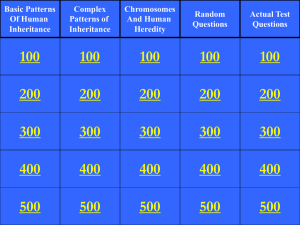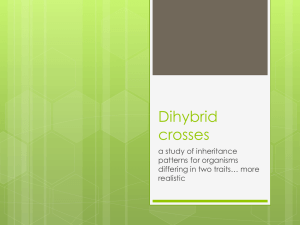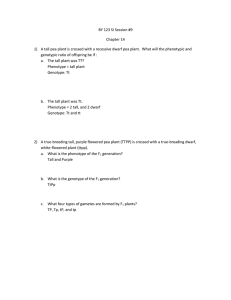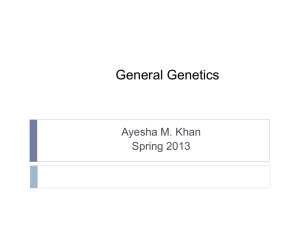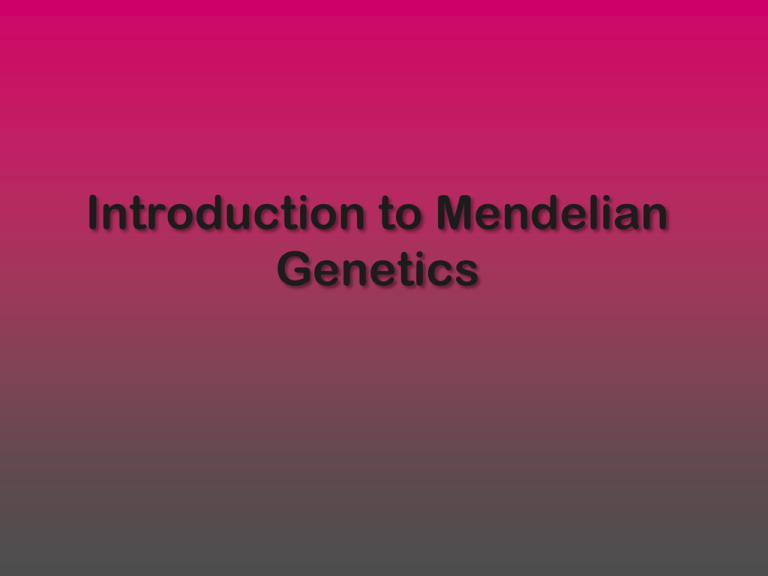
Introduction to Mendelian
Genetics
The Work of Gregor Mendel
A. Genetics is the scientific study of heredity.
Every living thing has a set of characteristics
inherited from its parent or parents!
B. Gregor Mendel
• Who & Where:
Austrian monk, “Father of
Genetics”, born 1822
• What:
His work was important to the
understanding of heredity. In
charge of monastery’s garden;
studied traits of pea plants
C. So Why Peas?
•
•
•
•
Pea plant flowers are closed
Self-fertilizing
True-breeding
Have 7 easily visible traits called
phenotypes
Every time Mendel crossed 2 different traits,
only ONE was seen in the offspring!
C. Mendel’s Principles
1. Principle of Dominance
2. Principle of Segregation
3. Principle of Independent
Assortment
Back to Mendel’s Experiments…
The Next Generation
If these hybrids self-pollinate..
The hidden trait returns!
F1 generation: Tt x Tt Result?
What happened to Recessive Allele?
Plants with
different
genotypes
(TT and Tt)
can have the
same phenotype
(“tall”).
• Genotype: genetic makeup of organism
• Phenotype: physical characteristics of an
organism
Genotype
Cc
TT
Pp
Phenotype
D. Principle of Dominance
Definition:
some alleles are dominant and others are
recessive. The dominant gene shows up in the
phenotype when present.
Example: Smooth peas
wrinkled peas
S
s
E. Principle of Segregation
• During sex cell formation, alleles separates
from each other
• Each gamete has one allele for each trait
• Each trait is controlled by a gene that is in two
contrasting forms
• The different forms of a gene are called alleles.
• Homozygous: two identical alleles
Example: TT or tt or SS or ss
• Heterozygous: two different alleles
for the same trait
Example: Tt or Ss
II. Probability and Punnett Squares
Why used?
Punnett squares used to predict and compare
genetic variations that will result from a cross
The Rules:
• Dominant traits are
the 1st letter and
CAPITAL
• Recessive are the 2nd
letter and lowercase
B. Practice
1) If a homozygous tall person was crossed with a
homozygous short person, what are probably offspring?
Tall= T
short= t
T
T
t
Tt
Tt
t
Tt
Tt
Punnett Square
2) Cross two heterozygous tall parents.
Tall= T
short= t
What is the
genotype ratio?
1 TT: 2 Tt: 1 tt
What is the
phenotype ratio?
3 Tall: 1 short
T
t
T
TT
Tt
t
Tt
tt
Punnett Square
3) The long-eared allele (L) is dominant
to the short-eared allele (l). Cross a
homozygous long ear with a
homozygous short-ear.
Cross the F1 generation and give the F2
results.
III. Independent Assortment
A. Mendel discovered that genes for different traits
segregate independently during gamete
formation
Ex. Wrinkled/Smooth and Yellow/Green peas
B. Dihybrid Cross:
two traits being crossed at the same time
Here is a heterozygous tall,
heterozygous purple plant:
TtPp
How can we figure out the alleles present in the gametes?
F
O
I
L
First Outer Inner Last
Using F.O.I.L., list the possible gametes:
Tall and Purple are dominant to short and white.
Example:
Cross two heterozygous tall,
heterozygous purple pea plants.
TtPp x TtPp
There are four possible gametes each
parent can make..
FATHER
TP
MOTHER
tP
Tp
tp
T P TTPP
TTPp
TtPP
TtPp
Tp TTPp
TTpp
TtPp
Ttpp
t P TtPP
TtPp
ttPP
ttPp
TtPp
Ttpp
ttPp
ttpp
tp
Results in fractions?
Ratio from heterozygous
Phenotypes:
dihybrid cross is
9/16
Tall, Purple?
ALWAYS
Tall, White? 3/16
9: 3: 3: 1
Short, Purple? 3/16
Alleles assort independently.
Short, White? 1/16
Use FOIL to set up these
examples:
FfPp:
SSTt:
DdRR:
FP
Fp
fP
fp
ST
ST
St
St
DR
DR
dR
dR
IV. Beyond Pure
Dominance….
Some alleles are not simply dominant or
recessive..
A. Incomplete dominance:
Alleles are expressed as a blend.
Each allele has a capital letter.
Red= R
Yellow= Y
1. Cross a red flower with a white
flower, showing incomplete dominance.
Red=R
White=W
W
W
R
R
RW
RW
RW
RW
Genotype: 100% RW
Phenotype: PINK!
D. Co-dominance
• Both traits dominate, seen separately!
Red Horse
White Horse
Give you ROAN!
1. Example of Codominant Problem
Red feathers are codominant to white feathers in chickens.
CR= red
CW= white
Cross a homozygous Red with a homozygous white
feathered chicken.
CR
CW
CW
CR CW
CR CW
CR
CR CW
CR CW
GENOTYPE:
100% CR CW
PHENOTYPE:
100%
Red and white mixed
feathers
C. Multiple Alleles
• One trait, many allele options!
• But remember: an individual cannot inherit more
than two actual alleles, even if more than two
possible alleles exist.
Example: Blood type
A, B, AB, O!
Blood Type Problem I
• Cross a homozygous Type A with a
heterozygous Type B. What are the
possible phenotypes of offspring?
IA
IB
I A IB
i
IA i
IA
Phenotypes:
50% Type AB
50% Type A
Blood Type Problem II
• Cross a heterozygous Type A man with a
heterozygous Type B woman. Is it
possible for them to have an O child?
IA
i
IB
I A IB
IB i
i
IA i
ii
Phenotypes:
25% Type AB
25% Type A
25% Type B
25% Type O
Blood Type Problem III
• Cross a heterozygous Rh+ man with a Rhwoman. What are the possible phenotypes
of offspring?
Rh+
Rh- Rh+ RhRh-
RhPhenotypes:
Rh- Rh- 50% Type +
50% Type -
Rh+ Rh- Rh- Rh-
Rabbits have 4 basic
colors (alleles!)
• brown
• chinchilla or grey
• It is recessive to brown.
• himalayan or white with black tips.
• It is recessive to both brown and chinchilla.
• albino
• It is recessive to all.
Full color
Himalayan
Chinchilla
AIbino
D. Polygenic Traits
• Traits produced by many genes with many
alleles
• Most human traits are polygenic
• Most variety of expression
• There are 3 genes that contribute to skin
color.. And many alleles for each gene!
More examples:
•
•
•
•
Height
Weight
Intelligence
Eye color
V. Sex Determination
In humans, the
X and Y
chromosomes
control the sex
of offspring.
Outcome is always 50% chance of a
male, and 50% chance of a female
Sex-linked traits
• Traits controlled by genes on the sex
chromosomes are called sex-linked.
• Alleles for sex-linked traits are written as
superscripts on the X chromosomes only.
Example: Red eyes in fruit flies
found in females
Males tend to have white eyes,
which is recessive.
XR XR
Xr y
• X and Y sex
chromosomes are nonhomologous
• Any allele on the X
chromosome will NOT
be masked by a
matching allele on the Y
chromosome.
Why are sex-linked disorders more common
in males than in females?
• Males have just one X chromosome
containing an allele. So all X-linked alleles
are automatically expressed in males, even if
they are recessive.
C. Examples of Sex-Linked
Color blindness
Duchenne Muscular Dystrophy
Hemophilia
Frank and Awilda at Breakfast
Frank: Are you sure you want to wear that new shirt to
work today? A green and red shirt like that would be
better for Christmas, not for St. Patrick's Day.
Awilda: Oh no! Not again! I hate being color blind! I
really thought this shirt was just different shades of
green. Where's the red?
At Dinner That Night
Awilda: We should try to find a way to make sure we
only have sons, no daughters. I don't want to have any
daughters who might be color blind and have so many
problems like I do. Color blindness wouldn't matter so
much for a boy.
Frank: Remember, the doctor said that, since I'm not color
blind, none of our daughters would be color blind, only our
sons.
Awilda: That doesn't make any sense. Our daughters should
be color blind like me and our sons should be normal like
you.
Frank: No, the doctor said the gene for color blindness is on
the X chromosome, so only our sons will inherit your
colorblindness.
Awilda: I don't agree. Girls have more X chromosomes than
boys, so girls should be more likely to be color blind.
Help Frank to explain to Awilda why the doctor was right
by answering the following questions.
1. What are the genotypes of Awilda and Frank? (Since the
allele for color blindness is recessive and located on the
X chromosome, use the symbol Xc for an X chromosome
with the allele for color blindness and XC for an X
chromosome with the normal allele.)
Awilda:
Frank:
Xc Xc
XC y
2. Draw the Punnett square for this couple and their
children. In this Punnett Square, circle each daughter and
use arrows to indicate any colorblind offspring.
X
X
y
C
c
X
c
XC Xc
XC Xc
Xc y
Xc y
C = normal vision
c = colorblind
3. Write an explanation to help Awilda understand why
their daughters will not be colorblind like their mother.
4. Explain why their sons will be colorblind even though
their father has normal vision.
5. Explain why having two X chromosomes decreases a
person’s risk of color blindness, instead of increasing their
risk, as Awilda fears.
Practice Problems
Hemophilia is an X-linked recessive
disease. Cross a heterozygous female
with a normal male.
Duchenne Muscular Dystrophy is an Xlinked recessive disease. Cross a
heterozygous female with a normal male.
Examples of Sex-linked Diseases
Colorblindness
D. Sex-Limited Traits
• A few traits are not caused by genes on the X or
the Y chromosome but still occur in only one sex
of animals
– Examples
• Antlers in deer- only bucks have antlers
• Milk yield in bovines is a trait expressed
by only cows (females)
• Eggs in chickens
E. Sex-Influenced
• Some traits are sex-influenced
because of genes that interact with a
substance (like hormones) that is not
produced equally in males and females
– Example: early pattern baldness
Baldness Sample Problem
• Baldness is a dominant trait.
Heterozygous men are bald, BUT
heterozygous women have all hair.
• Cross a Heterozygous woman with a normal
hair male. Bb x bb
Genotype - Phenotype
If all girls?
If all boys?
B
b
b
B b
b b
b
B b
b b
Human Genetic Disorders
Down Syndrome
Symptoms:
learning difficulties, mental retardation, a
characteristic facial appearance, and poor
muscle tone
Detection/
Frequency?
1 in 1000 live born infants
Mode of
Inheritance/
Chromosome
Chromosome 21, nondisjunction
Treatment
Physical therapy for muscle weakness, heart
is checked regularly for problems,
educational therapy
Prognosis
May have shortened life span
Marfan Syndrome
Symptoms:
Myopia, retinal detachment, bone overgrowth
and loose joints, may have long thin arms and
legs, bent chest inwards or outwards
Detection/
Frequency?
occurring 1 in 10,000 to 20,000 individuals
Mode of
Inheritance/
Chromosome
Autosomal dominant, Chromosome 15
Treatment
Surgery to correct skeletal problems, sight
issues fixed with glasses, must avoid contact
sports
Red-Green Colorblindness
Symptoms:
Detection/
Frequency?
Mode of
Inheritance/C
hromosome
Treatment
Prognosis
Retinoblastoma
Symptoms:
Detection/
Frequency?
Mode of
Inheritance/C
hromosome
Treatment
Prognosis
Albinism
Symptoms:
Detection/
Frequency?
Mode of
Inheritance/C
hromosome
Treatment
Prognosis
Duchenne Muscular
Dystrophy
Symptoms:
Detection/
Frequency?
Mode of
Inheritance/C
hromosome
Treatment
Prognosis
Turner Syndrome
Symptoms:
Detection/
Frequency?
Mode of
Inheritance/C
hromosome
Treatment
Prognosis
Dwarfism
(Achondroplasia)
Symptoms:
Detection/
Frequency?
Mode of
Inheritance/
Chromosome
Treatment
Prognosis
Hemophilia
Symptoms:
Detection/
Frequency?
Mode of
Inheritance/
Chromosome
Treatment
Prognosis
Huntington’s Disease
Symptoms:
Detection/
Frequency?
Mode of
Inheritance/C
hromosome
Treatment
Prognosis
Tay-Sach’s
Symptoms:
Detection/
Frequency?
Mode of
Inheritance/C
hromosome
Treatment
Prognosis
Klinefelter’s
Symptoms:
Detection/
Frequency?
Mode of
Inheritance/C
hromosome
Treatment
Prognosis
Cystic Fibrosis
Symptoms:
Detection/
Frequency?
Mode of
Inheritance/C
hromosome
Treatment
Prognosis
Sickle Cell Anemia
Symptoms:
Detection/
Frequency?
Mode of
Inheritance/C
hromosome
Treatment
Prognosis
Phenylketonuria (PKU)
Symptoms:
causes increase of phenylalanine in blood results in mental retardation, heart problems,
small head size (microcephaly) and
developmental delay
Detection/
Frequency?
1 in 10,000 to 1 in 15,000 newborn babies
Mode of
Inheritance/C
hromosome
Treatment
Prognosis
Limiting dietary intake of phenylalanine
Symptoms:
Detection/
Frequency?
Mode of
Inheritance/C
hromosome
Treatment
Prognosis
Symptoms:
Detection/
Frequency?
Mode of
Inheritance/C
hromosome
Treatment
Prognosis
11.5 Linkage & Gene Maps
Thomas Hunt Morgan, 1910
Research fruit flies
Found 50+ Drosophilia genes
Many of them “linked” together
All the genes from one group were
inherited together
Chromosomes assort independently,
not the genes
How did Mendel miss this linkage?
By pure luck, the 6 genes he looked at
were on different chromosomes
Gene Maps
Crossing-over sometimes separates genes on
the same chromosomes onto homologous
chromosomes.
– Occasionally separate and exchange linked genes and
produce new combinations
The farther apart two genes are, the more
likely they are to be separated by a
crossover in meiosis.
Alfred Sturtevant created a gene map
showing the locations of each known gene
on one of the Drosophila chromosomes


